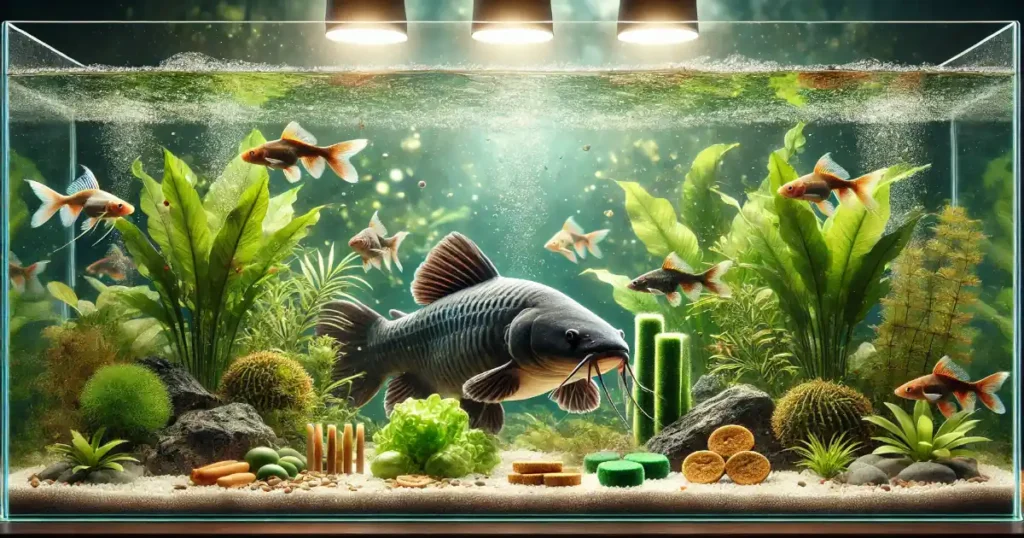Introduction to Catfish Food
Understanding the Importance of Catfish in Various Ecosystems
Catfish are among the most adaptable and widely distributed freshwater fish species, recognized for their unique appearance and remarkable survival capabilities. With over 3,000 species globally, catfish thrive in diverse environments, from tranquil home aquariums to vast commercial fish farms. Their whisker-like barbels not only define their appearance but also play a crucial role in their feeding habits, allowing them to detect food in murky waters.
In the world of aquaculture, catfish are prized for their rapid growth and the quality of their meat, which is a staple in many diets around the world. Additionally, in home aquariums, catfish are cherished for their role in maintaining tank cleanliness and their compatibility with other fish species. Given their significant roles, providing the right food is essential to ensure their health, longevity, and overall well-being.
Purpose of the Article
This guide aims to provide comprehensive insights into the feeding habits and nutritional needs of catfish. Whether you are a commercial fish farmer, an aquarium enthusiast, or a conservationist, this article will help you understand the best practices for feeding catfish, ensuring they receive the nutrition they need to thrive.
I. The Dietary Needs of Catfish
Natural Feeding Behavior
Catfish are generally omnivorous, consuming both plant and animal matter in their natural habitats. Some species may lean towards a more herbivorous or carnivorous diet depending on their environment. Typically, catfish are bottom feeders, using their sensitive barbels to detect food in the substrate, even in complete darkness. Their natural diet includes small fish, insects, crustaceans, algae, and detritus, making them versatile feeders.
Nutritional Essentials for Growth and Health
A balanced diet is crucial for the growth and health of catfish. They require a mix of proteins, fats, and carbohydrates, along with essential vitamins and minerals. Proteins are particularly important for muscle development and overall growth, while fats provide the necessary energy for their daily activities. Carbohydrates, though needed in smaller amounts, also contribute to their energy supply. Additionally, vitamins and minerals play critical roles in supporting their immune system and metabolic functions.
Impact of Nutrition on Catfish Development
The quality of the diet directly influences the growth rate and overall health of catfish. In commercial farming, where efficiency and growth rates are paramount, a well-balanced diet can lead to faster growth and a quicker turnaround time to market. Proper nutrition also bolsters the immune system, reducing the risk of diseases and infections, which is especially important in high-density farming or aquarium settings.
II. Types of Food Suitable for Catfish
Commercially Prepared Pellets
Pellets are a convenient and popular choice for feeding catfish, particularly in controlled environments like aquariums and fish farms.
- Floating Pellets: These pellets are designed to float on the water surface, encouraging catfish to come up and feed. While they are easy to use and allow for better observation of feeding behavior, they may not be suitable for all catfish species, particularly those that prefer to feed at the bottom.
- Sinking Pellets: More appropriate for bottom feeders, sinking pellets quickly reach the substrate where catfish naturally search for food. These pellets are ideal for species that prefer to stay near the bottom of the tank or pond.
Live Foods for Natural Feeding Stimulation
Live food can significantly enhance the diet of catfish by mimicking their natural feeding habits.
- Worms (Earthworms, Bloodworms, Tubifex): Worms are a rich source of protein and are readily accepted by most catfish species. Earthworms are ideal for larger species, while bloodworms are suitable for smaller or juvenile catfish.
- Insects (Crickets, Mealworms): Offering insects to catfish not only provides nutritional benefits but also stimulates their natural predatory instincts. This can be especially useful in reducing stress and promoting healthy activity levels.
- Small Fish: Some larger catfish species may consume small live fish. While this is a natural part of their diet, it is important to ensure that the live fish are healthy to prevent the introduction of diseases.
Frozen and Freeze-Dried Alternatives
For those who prefer the convenience of non-live foods, frozen and freeze-dried options are excellent alternatives.
- Bloodworms: A staple in many catfish diets, bloodworms provide essential nutrients and are easy to store and portion. They are particularly beneficial for smaller species or juveniles.
- Brine Shrimp: Brine shrimp are highly nutritious and are a favorite among many catfish species. They can be fed regularly or as a special treat, providing variety in the diet.
- Fish Fillets: Larger catfish species can benefit from the occasional feeding of fish fillets. These should be prepared in bite-sized pieces to avoid overfeeding and ensure easy consumption.
Incorporating Vegetable Matter
Some catfish species require a diet that includes vegetable matter, particularly those that are herbivorous or omnivorous.
- Algae Wafers: Algae wafers are specifically formulated for catfish that naturally feed on algae. These wafers provide essential nutrients and help replicate the natural diet of herbivorous catfish species.
- Blanched Vegetables (Zucchini, Spinach, Peas): Blanched vegetables are an excellent addition to the diet of catfish that consume plant matter. These vegetables should be lightly cooked to soften them, making them easier for the fish to eat.
Homemade Food Options
For those who enjoy a more hands-on approach to feeding their fish, homemade catfish food can be a rewarding option.
- Gel Food: Gel food allows for the combination of various ingredients, including fish meal, vegetables, and vitamins, into a digestible gel form. This customizable option can be tailored to the specific needs of your catfish.
- Meat Scraps: Lean meat scraps can be offered occasionally to larger catfish species. It’s important to avoid fatty or seasoned meats, as these can be harmful to fish.
III. Tailoring Feeding Strategies to Different Environments
Aquarium Feeding Practices
Feeding catfish in an aquarium setting requires careful consideration of the fish’s needs and the environment.
- Frequency and Portion Control: In an aquarium, it is crucial to avoid overfeeding, as uneaten food can quickly degrade water quality. Feeding catfish once or twice a day in small portions that they can consume within a few minutes is usually sufficient.
- Catering to Species-Specific Diets: Different catfish species have different dietary requirements. For example, a Plecostomus will benefit from more vegetable matter, while a Channel Catfish may require a protein-rich diet. Offering a variety of foods helps ensure that all nutritional needs are met.
Feeding Catfish in Ponds
Pond-raised catfish require feeding strategies that account for environmental factors and growth goals.
- Seasonal Feeding Adjustments: Catfish metabolism changes with the seasons. During warmer months, they are more active and require more food. In contrast, during colder months, their feeding should be reduced to prevent waste and maintain water quality.
- Optimizing Feeding in Commercial Operations: In commercial pond operations, feeding schedules are designed to maximize growth rates while minimizing waste. Automated feeders and nutritionally balanced pellets are often used to ensure efficiency.
Feeding Wild Catfish
Feeding wild catfish is less about direct feeding and more about supporting their natural diet through conservation efforts.
- Natural Diet Considerations: Wild catfish consume a varied diet based on what is available in their environment, including smaller fish, insects, and plant matter. Understanding these natural diets is crucial when engaging in conservation or habitat restoration efforts.
- Supporting Wild Populations Through Supplementation: In areas where natural food sources are depleted, supplemental feeding can help support wild catfish populations. Techniques such as habitat enhancement and strategic feeding can aid in maintaining healthy fish populations.
IV. Avoiding Common Feeding Mistakes
The Dangers of Overfeeding
Overfeeding is a common issue that can lead to several problems in catfish care.
- Consequences of Overfeeding: Overfeeding can cause water quality issues due to uneaten food decomposing and releasing harmful substances. It can also lead to obesity and other health problems in catfish.
- Tips to Prevent Overfeeding: To avoid overfeeding, feed only the amount of food that catfish can consume in a few minutes. Regularly observe their feeding habits and adjust portions as necessary.
Inappropriate Food Choices
Feeding catfish inappropriate foods can lead to nutritional imbalances and health issues.
- Foods to Avoid: Avoid feeding catfish foods that are high in fat or contain artificial additives. Human foods, such as bread, should never be given to catfish, as they can cause digestive issues.
- Identifying Nutritional Deficiencies: Signs of nutritional deficiencies in catfish include slow growth, color fading, and lethargy. Addressing these issues requires reevaluating the diet and possibly introducing more varied or specialized food sources.
Species-Specific Dietary Needs
Ignoring the specific dietary needs of different catfish species can lead to health problems.
- Understanding Individual Needs: Each catfish species has unique dietary requirements. Researching and understanding these needs is essential for providing the right nutrition.
- Challenges in Mixed-Species Environments: In mixed-species tanks or ponds, ensure that all species have access to the appropriate food. This may involve using different types of food or feeding at different times to cater to each species’ needs.
Proper Food Storage and Handling
Improper storage and handling of catfish food can compromise its quality and safety.
- Avoiding Spoiled Food: Always store catfish food in a cool, dry place and check expiration dates. Feeding spoiled food can introduce harmful bacteria and parasites into the environment.
- Best Practices for Preparation: Preparing catfish food properly, whether it’s store-bought or homemade, is crucial for maintaining its nutritional value. For homemade food, make small batches to ensure it remains fresh.
V. Innovations and Future Trends in Catfish Nutrition
Advances in Catfish Feed Technology
Recent innovations in feed technology are enhancing the way catfish are nourished.
- Improved Pellet Formulations: Advances in pellet technology have led to more nutritionally complete feeds, designed to cater to specific species and life stages. These improvements not only boost growth rates but also enhance overall fish health.
- Research-Driven Nutritional Strategies: Ongoing research into fish nutrition is helping to develop feeds that promote better health outcomes, reducing the need for medications and interventions.
Sustainable Feeding Practices
Sustainability is increasingly important in aquaculture, and new feeding practices are emerging to address environmental concerns.
- Eco-Friendly Feed Options: Organic and eco-friendly feeds are becoming more popular, offering a more sustainable approach to catfish farming. These feeds minimize environmental impact and promote healthier fish.
- Reducing Environmental Footprint: Sustainable feeding practices, such as using plant-based proteins and improving feed conversion ratios, are helping to reduce the environmental footprint of catfish farming.
Looking Ahead: Future Trends in Catfish Nutrition
The future of catfish nutrition is likely to be shaped by several emerging trends.
- Probiotics and Functional Feeds: The use of probiotics and functional feeds is growing, offering benefits such as improved gut health and enhanced immune function.
- Alternative Protein Sources: As demand for fish meal increases, alternative protein sources, such as insect-based feeds, are being explored. These options are sustainable and can meet the nutritional needs of catfish effectively.
Conclusion
Summarizing Key Takeaways
Providing the right food for catfish is essential for their growth, health, and overall well-being. By understanding their dietary needs and tailoring feeding strategies to their environment, you can ensure that your catfish thrive, whether in an aquarium, pond, or the wild.
Final Thoughts on Catfish Care
Feeding catfish is a nuanced task that requires attention to detail and a commitment to understanding their specific needs. Proper nutrition is the foundation of a healthy, vibrant catfish population, and by staying informed, you can provide the best care possible.
Encouragement to Continue Learning
The field of catfish nutrition is constantly evolving, with new research and innovations emerging regularly. Stay curious, keep learning, and explore new ways to enhance the health and well-being of your catfish.
Frequently Asked Questions (FAQs)
What are the main types of food suitable for catfish?
Catfish can eat commercial pellets, live food like worms, insects, and vegetable matter like algae wafers and blanched vegetables.
How often should I feed my catfish in an aquarium?
Feed your aquarium catfish once or twice a day, offering only as much food as they can consume within a few minutes to avoid overfeeding.
Can I use homemade food for catfish?
Yes, homemade options like gel food and meat scraps can be beneficial, but it’s important to tailor them to the specific nutritional needs of your catfish.
What are some signs that I might be overfeeding my catfish?
Signs of overfeeding include cloudy water, leftover food at the bottom of the tank or pond, and bloated or lethargic fish.
Is live food necessary for catfish, or can they thrive on pellets alone?
While catfish can thrive on pellets, incorporating live food like worms or insects can enhance their diet and stimulate natural feeding behaviors.
What are some new trends in catfish nutrition?
Trends include sustainable feeding practices, such as plant-based protein sources and the use of probiotics to improve fish health.







